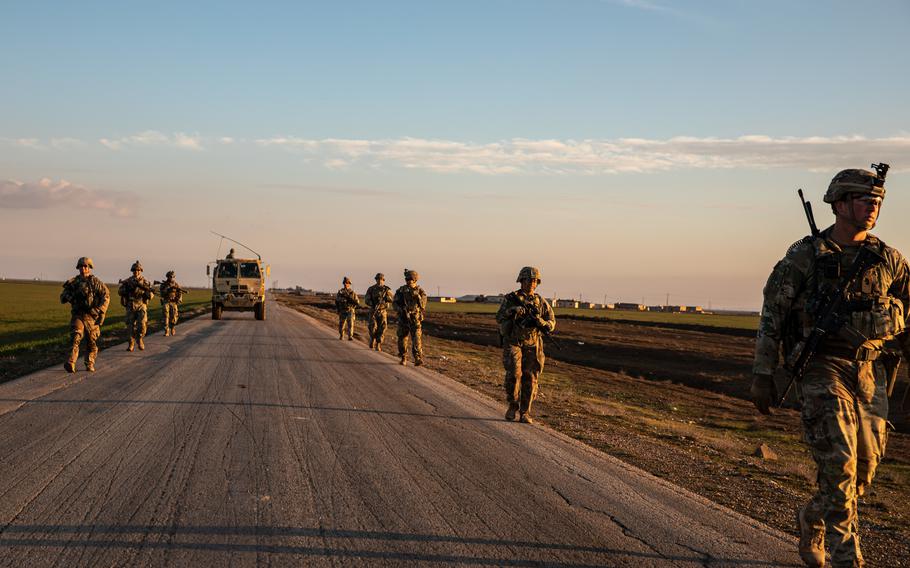
U.S. Army Soldiers, assigned to Bravo Company, 1st Battalion, 118th Infantry Regiment, 37th Infantry Brigade Combat Team, Combined Joint Task Force — Operation Inherent Resolve, during a dismounted patrol, Syria, Feb. 3, 2023. (Julio Hernandez/U.S. Army)
Amid a recent flurry of Middle East diplomacy, the Trump administration’s Syria policy is beginning to take shape. In mid-April, the U.S. wisely began reducing its troop presence in the country. In his visit to the region, President Donald Trump made a surprise announcement in Riyadh, Saudi Arabia, that the U.S. would lift onerous Assad-era sanctions on the war-torn nation “to give them a chance at greatness.” A day later, Trump met with Syria’s transitional president, Ahmad al-Sharaa — the first meeting in 25 years between Syrian and U.S. presidents — and said he was considering normalizing U.S. relations with Syria.
These moves should be followed by a complete withdrawal of U.S. troops. Combined, these policies could significantly advance U.S. interests in the Middle East.
A total U.S. withdrawal would get troops out of harm’s way and help disentangle Washington from a region of declining strategic importance. Meanwhile, the sanctions cessation can help set Syria, long a regional vector for instability and terrorism, on a path to stability and regional integration, which gives Washington even more significant strategic rationale for pulling back from the Middle East.
Even with the administration’s initial drawdown of troops, there are still over 1,000 in the country — and they lack a clear mission or a timetable for withdrawal. Trump was suspicious about the value of U.S. troops in Syria in his first term, but strategic factors, bureaucratic pushback and bipartisan criticism thwarted a withdrawal back then.
But his suspicion was warranted: The U.S. troop presence has long been a strategic liability, as they have been vulnerable to an attack that could lead to lost service members and potentially drag the U.S. into war. Before Syrian President Bashar Assad’s ouster in December, U.S. troops in Syria were in close proximity to Russian, Iranian and Assad regime forces and a mélange of extremist groups that rampaged over Syria during the civil war. Since Hamas’ Oct. 7, 2023, attack, U.S. troops in the region have come under attack at least 400 times. Fortunately, casualties have been limited so far and have not led to a major escalation. Getting U.S. troops out of Syria removes that possibility altogether.
One of the main reasons often cited by proponents of a sustained U.S. troop presence in Syria is to tamp down Islamic State’s resurgence. But none of the major players in the region wants to see ISIS reemerge, whether that’s Syria’s transitional government, Turkey, Iraq, Jordan, the Kurds, or Iran. ISIS has ramped up attacks since Assad’s ouster, but the remnants of the terrorist group — and its legacy — are problems that the region can and should manage on its own.
If implemented, Trump’s decision to remove sanctions amounts to a no-cost investment in regional stability. The U.S. levied sanctions on the Assad regime for its horrific crimes against its own people. But Assad is gone, and continuing the sanctions will further suffocate Syria’s economy, snuff out the chance for a successful political transition, immiserate the Syrian people even more, and push the transitional government to look for Russian support.
On one hand, there are legitimate and concerning questions about al-Sharaa and his transitional government. Al-Sharaa was the leader of Hayat Tahrir al-Sham (HTS), an al-Qaida offshoot that overthrew Assad. Al-Sharaa’s government is stocked with figures from HTS and other violent groups with worrying histories. Since Assad’s overthrow, there have been several episodes of sectarian violence, some attributed to transitional government forces. None of this should be dismissed.
On the other hand, over 90% of Syria’s population lives below the poverty line. Roughly 16 million Syrians need humanitarian assistance, including 12 million who are food insecure, with three million facing acute food insecurity. Approximately 7.2 million people are internally displaced and another six million have sought refuge abroad. The education and health care systems are in shambles. The transitional government cannot rebuild the country without sanctions relief.
This is a recipe for violence and chaos. We’ve already seen the implications of a failed Syria for regional and global security, whether it’s breeding new terrorist groups or mass migration to Europe, both of which had ripple effects on U.S. interests.
Sanctions relief provides the opportunity for Syria’s economy to recover, opens the door for international investment, and would give the government the ability to begin to address the country’s manifold challenges.
And the U.S. doesn’t have to spend a dollar to do it. The U.S. should step up diplomatic and economic engagement with Syria while monitoring the progress of its transition.
In a remarkable speech in Riyadh, Trump assailed Washington’s post-9/11 policies of intervention and nation-building in the Middle East. And in recent weeks, his administration has made significant progress in rightsizing U.S. policy in the region by emphasizing diplomacy in the pursuit of American interests. Nuclear talks with Iran, the cease-fire with the Houthis, and a push to end the war in Gaza can all help to reduce the U.S. presence in the region and propel a reorientation toward pressing strategic priorities. Withdrawing U.S. troops from an aimless deployment in Syria is a vital next step.
Adam Gallagher is a contributing fellow at Defense Priorities and a strategic leaders fellow at the John Quincy Adams Society.